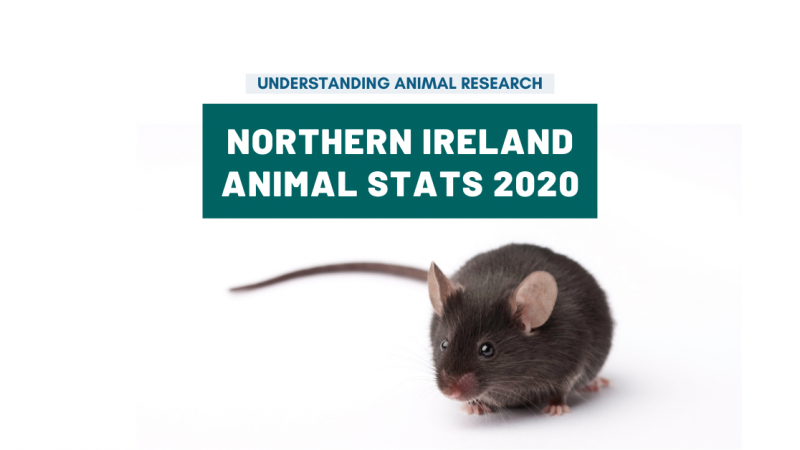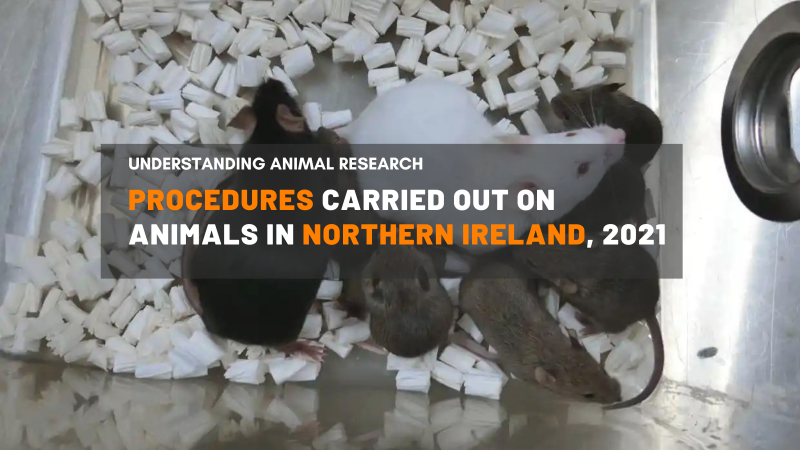
Latest figures show a decrease in animals used in research in Northern Ireland in 2023
-
Number of procedures on animals in 2023 has decreased by 11.4% to 25,345
-
Mice, fish, rats, and birds account for 93% of all procedures
-
Cats and dogs account for 0.8% of all procedures
-
Sub-threshold and mild procedures account for 54%
-
Northern Ireland represents 0.9% of UK animal research
The Department of Health in Northern Ireland has released its annual statistics on the number of animals used in scientific, medical and veterinary research in 2023. The figures show that 25,345 procedures were carried out in Northern Ireland in 2023, 11.4% less than in 2022.
93% of the procedures were carried out in mice, fish, rats, and birds, whereas cats and dogs accounted for 0.8% of all procedures in 2023.
While mice are the most common species used (81% of the total), pigs, sheep, and cattle together account for 6.2% of research, reflecting the large amount of agricultural research conducted in Northern Ireland.
In 2023, England, Scotland and Wales carried out 2,681,686 procedures on animals, of which 95% were on mice, fish, rats, and birds. The 25,345 procedures carried out in Northern Ireland represent approximately 0.9% of animal research across the UK.
What is a procedure?
Any procedure applied to a protected animal for an experimental or other scientific purpose, or for an educational purpose, that may have the effect of causing an animal pain, suffering, distress or lasting harm equivalent to, or higher than, that caused by the introduction of a needle in accordance with good veterinary practice.
How many animals are used?
The number of procedures carried out in a year does not equal the number of animals that have been used in procedures that year. This is because some animals may be used more than once i.e. ‘re-used’, in certain circumstances. These instances are counted as separate, additional, procedures. As a result, the number of procedures is usually slightly higher than the number of animals used. 24,810 animals were used for the first time in 2023.
Specially protected species
Specially protected species refers to cats, dogs, horses, and non-human primates (monkeys) - they are subject to additional protection under Section 5C of the Animal (Scientific Procedures) Act 1986. This means these species can only be used when no other species is suitable. These species were used in 0.83% of all procedures. No monkeys have been used in Northern Ireland since the enactment of the Animals (Scientific Procedures) Act in 1986. Horses have not been used in Northern Ireland since 2008.
Number of Animal Procedures in Northern Ireland in 2023
|
Species |
Experimental Procedures |
% |
Procedures for the Creation & Breeding of Genetically Altered Animals |
% |
Total Procedures (2023) |
% |
% change from 2022 |
|
Mice |
14,182 |
74.64 |
6,293 |
99.18% |
20,475 |
80.79% |
-4.32% |
|
Rats |
666 |
3.51% |
52 |
0.82% |
718 |
2.83% |
-34.61% |
|
Cats |
22 |
0.12% |
0 |
0.00% |
22 |
0.09% |
-72.15% |
|
Dogs |
186 |
0.98% |
0 |
0.00% |
186 |
0.73% |
108.99% |
|
Domestic fowl |
1,617 |
8.51% |
0 |
0.00% |
1,617 |
6.38% |
-31.19% |
|
Pig |
270 |
1.42% |
0 |
0.00% |
270 |
1.07% |
-83.60% |
|
Sheep |
751 |
3.95% |
0 |
0.00% |
751 |
2.96% |
80.10% |
|
Cattle |
559 |
2.94% |
0 |
0.00% |
559 |
2.21% |
-8.51% |
|
Fish |
701 |
3.69% |
0 |
0.00% |
701 |
2.77% |
-12.38% |
|
Other animals |
46 |
0.24% |
0 |
0.00% |
46 |
0.18% |
-58.18% |
|
Total |
19,000 |
74.97% |
6,345 |
25.03% |
25,345 |
100% |
-11.38% |
Purpose of procedures
Procedures related to the creation and breeding of genetically altered animals decreased by 15.50% compared to 2022, while experimental procedures increased by 3.74%.
Procedures for creation and breeding involve the breeding of animals whose genes have mutated or have been modified. These animals are used to produce genetically altered offspring for use in experimental procedures but are not themselves used in experimental procedures.
25% (6,345) of all procedures were for the creation or breeding of genetically altered (GA) animals. Of these 6,345 procedures:
-
100% were for the purpose of maintenance of established lines of genetically altered animals
-
0% were for the creation of new lines of genetically altered animals
Experimental procedures involve using animals in scientific studies for purposes such as basic research and the development of treatments, safety testing of pharmaceuticals and other substances, education, specific surgical training and education, environmental research and species protection.
75% (19,000) of all procedures were for experimental purposes. This includes basic research, which expands our knowledge of living organisms and the environment; applied research, which addresses the prevention of disease and development of treatments; and regulatory research, which includes studies aimed at ensuring product safety and the effectiveness of pharmaceuticals. Of these 22,484 procedures:
-
50% were for applied research
-
36% were for basic research
-
11% were for protection of natural environmental research
-
2% were for regulatory research, forensic enquiries, and preservation of species research
The top three research areas for basic research were: sensory organs, oncology, and the immune system. The top three research areas for applied research were: human cancer, human immune disorders and human infectious disorders.
The use of animals to test tobacco products was banned in the UK in 1997 and it has been illegal to use animals to test cosmetic products in this country since 1998. A policy ban on household testing using animals was introduced in 2010. Since 2013, it has been illegal to sell or import cosmetics anywhere in the EU where the finished product or its ingredients have been tested on animals.
Severity of procedures
Severity assessments measure the harm experienced by an animal during a procedure. A procedure can be as mild as an injection, or as severe as an organ transplant.
Severity assessments reflect the peak severity of the entire procedure and are classified into five different categories:
Sub-threshold: When a procedure did not cause suffering above the threshold for regulation, i.e. it was less than the level of pain, suffering, distress or lasting harm that is caused by inserting a hypodermic needle according to good veterinary practice.
Non-recovery: When the entire procedure takes place under general anaesthetic and the animal is humanely killed before waking up.
Mild: Any pain or suffering experienced was only slight or transitory and minor so that the animal returns to its normal state within a short period of time. For example, the equivalent of an injection or having a blood sample taken.
Moderate: The procedure caused a significant and easily detectable disturbance to an animal’s normal state, but this was not life-threatening. For example, surgery is carried out under general anaesthesia followed by painkillers during recovery.
Severe: The procedure caused a major departure from the animal’s usual state of health and well-being. This would usually include long-term disease processes where assistance with normal activities such as feeding and drinking were required, or where significant deficits in behaviours/activities persist. Animals found dead are commonly classified as severe as pre-mortality suffering often cannot be assessed. Most severe procedures arise in regulatory testing such as the evaluation of the toxicity of drugs.
Sub-threshold and mild procedures account for 54% of all procedures in 2023.
Severity of Animal Procedures in Northern Ireland in 2023
|
Severity |
Experimental Procedures |
% |
Procedures for the Creation & Breeding of Genetically Altered Animals |
% |
Total Procedures (2022) |
% |
Change from 2022 |
|
Sub-threshold |
380 |
2.00% |
4,736
|
74.64%
|
5,116
|
20.19%
|
↓
|
|
Non-recovery |
64
|
0.34%
|
13
|
0.20%
|
77
|
0.30%
|
↓
|
|
Mild |
6,973 |
36.70% |
1,519 |
23.94% |
8,492 |
33.51% |
↓ |
|
Moderate |
11,400 |
60.00% |
9 |
0.14%
|
11,409 |
45.01% |
↓
|
|
Severe |
183 |
0.96% |
68 |
1.07% |
251 |
0.99% |
= |
|
Total |
19,000 |
|
6,345 |
|
25,345 |
100% |
|
Why has the total number of procedures decreased this year?
The total number of animals used in research is affected by many factors. The overall funding for life sciences in the United Kingdom, as well as the relative funding in other countries, will change the amount of science done, a proportion of which will involve animals.
Animals are used alongside other techniques such as cell cultures, human studies and computational models. These methods are used – often in tandem – to answer the key biological questions necessary to understand and treat disease.
Animal research is strictly regulated in the UK. Every procedure, from a simple blood test to major surgery, requires individual, establishment and project licences, as well as approval from an Animal Welfare and Ethical Review Body. Before an animal is used, researchers must show that the knowledge could not be acquired using non-animal methods.
While the government produces these statistics on an annual basis, more organisations than ever before are openly publishing their own figures on their websites. This move towards greater transparency has been bolstered by the Concordat on Openness on Animal Research in the UK, which has been signed by 126 organisations since it launched in 2014.
See here for historical animal use statistics.
Last edited: 4 April 2025 13:47



